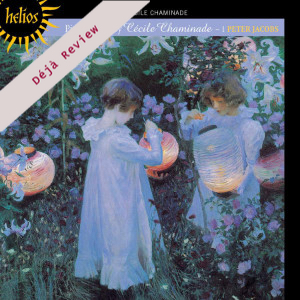
Déjà Review: this review was first published in October 2005 and the recording is still available.
Cécile Chaminade (1857-1944)
Piano Music Volume 1
Peter Jacobs (piano)
rec. 1991
Hyperion CDH55197 [71]
For too long Cécile Chaminade’s charming, enchanting music lay forgotten, languishing below the musical radar because of two unforgivable sins. First, she composed only slight, tuneful and undemanding salon pieces and, second, she was a woman. Therefore, in the eyes of the music establishment she was beyond the pale; most dictionaries and books, either ignoring her existence or including only the briefest, supercilious entries.
Now through this recording originally released by Hyperion in 1991 we have the opportunity of assessing the undeniable worth of these exquisitely crafted little compositions. In addition there are two other volumes in the Hyperion series as well as recordings like Anne Sofie von Otter’s 2001 recital of Chaminade songs accompanied by Bengt Forsberg on DG 471 331-2. The same disc also includes five pieces for violin and piano.
Chaminade, born in Paris, was something of a musical prodigy, writing sacred music at the age of eight. Bizet, no less, noted her talent and advised her parents to ensure she had a formal musical education. But of course women were not allowed into the Paris Conservatoire; however, she was able to study piano with Le Couppey and with Savard for counterpoint, harmony and fugue and violin under Martin Marsick, a pupil of Joachim, plus composition with Benjamin Godard.
During her long life – she died in Monte Carlo in 1944 – Chaminade produced some 350 works including a comic opera, a ballet, a choral symphony (Les amazons), chamber and orchestral music and about one hundred songs. But the area in which she excelled and was the most productive was the short lyric piano piece, many of which became very popular bringing her considerable success and fame in France Britain and the USA.
As I listen to a CD, I habitually mark numbers that particularly impress me for comment in my review. On this occasion I was so charmed, that I found that I had marked practically every one of its nineteen pieces. So I will just restrict myself to mentioning just a half dozen or so.
The best known of this set is probably Automne. Conceived in the Romantic etude tradition of Chopin and Liszt with something, too, of an early Fauré nocturne, this gem at nearly seven minutes, the most substantial of all the numbers here, is beautifully evocative of autumnal serenity and melancholic nostalgia but not without a central stormy turbulence. I was attracted to the three Études: the Étude mélodique has a most disarming Schumann-like tune while the Étude pathétique is correspondingly passionate, vehement even. The Étude scholastique is hardly academic, more of a lampoon of the strict routines demanded by the conservatories; written in the Baroque style, the piece is quite a brilliant toccata with its fast triplets giving it the feel of a gigue. There are hints of Brahms and Elgar. Pêcheurs de nuit (‘Fishermen at night’) is another imposing piece. Barcarolle-like it has a sense of the sinister and the tragic as well a heroic swagger. Two lovely pieces Romance in D and Solitude, the second of Chaminade’s Poèmes provençales, and reminiscent of material used by Poulenc, are redolent of sweet melancholy.
Norman Demuth , in his study of French piano music was one of the few commentators who did have something of value to say about Chaminade, “she was nearly a genius in that she knew exactly what and how to write for pianists of moderate ability … we wish every writer for the piano had her innate gifts and could be equally musicianly in their own ways”. But of Elévation (‘Exaltation’) he was scathing, calling it ‘dreadful’. Surely a rather harsh and dismissive judgement based on the evidence of the delicacy and refinement of Peter Jacobs’s reading which reveals a charming and innocent little confection.
But I am being carried away, mentioning well over those half dozen pieces, and I must also mention L’Ondine the little tone picture of the water nymph, a limpid and rippling enchantment.
An undemanding and tuneful collection that will enchant all but the strictest classicists and the hardest-hearted.
Ian Lace
Help us financially by purchasing from


Contents
Chaconne Op. 8
Autrefois No. 4 of Pièces humoristiques Op. 87
Callirhoë – Air de Ballet (no opus number)
Solitude No. 2 of Poèmes provençales Op. 127
Romance in D major Op. 137
L’Ondine Op. 101
Scherzo in C major No. 1 of Études de concert Op. 35
Automne No. 2 of Études de concert Op. 35
Thème varié in A major Op. 89
Sérénade in D major Op. 29
Souvenance No. 1 of Romances sans paroles Op. 76
Élévation in E major No. 2 of Romances sans paroles Op. 76
Étude mélodique in G flat major Op. 118
Étude pathétique in B minor Op. 124
La Lisonjera (no opus number)
Valse romantique Op. 115
Pêcheurs de nuit No. 4 of Poèmes provençales Op. 127
Deuxième valse Op. 77
Études scholastique Op. 139


















